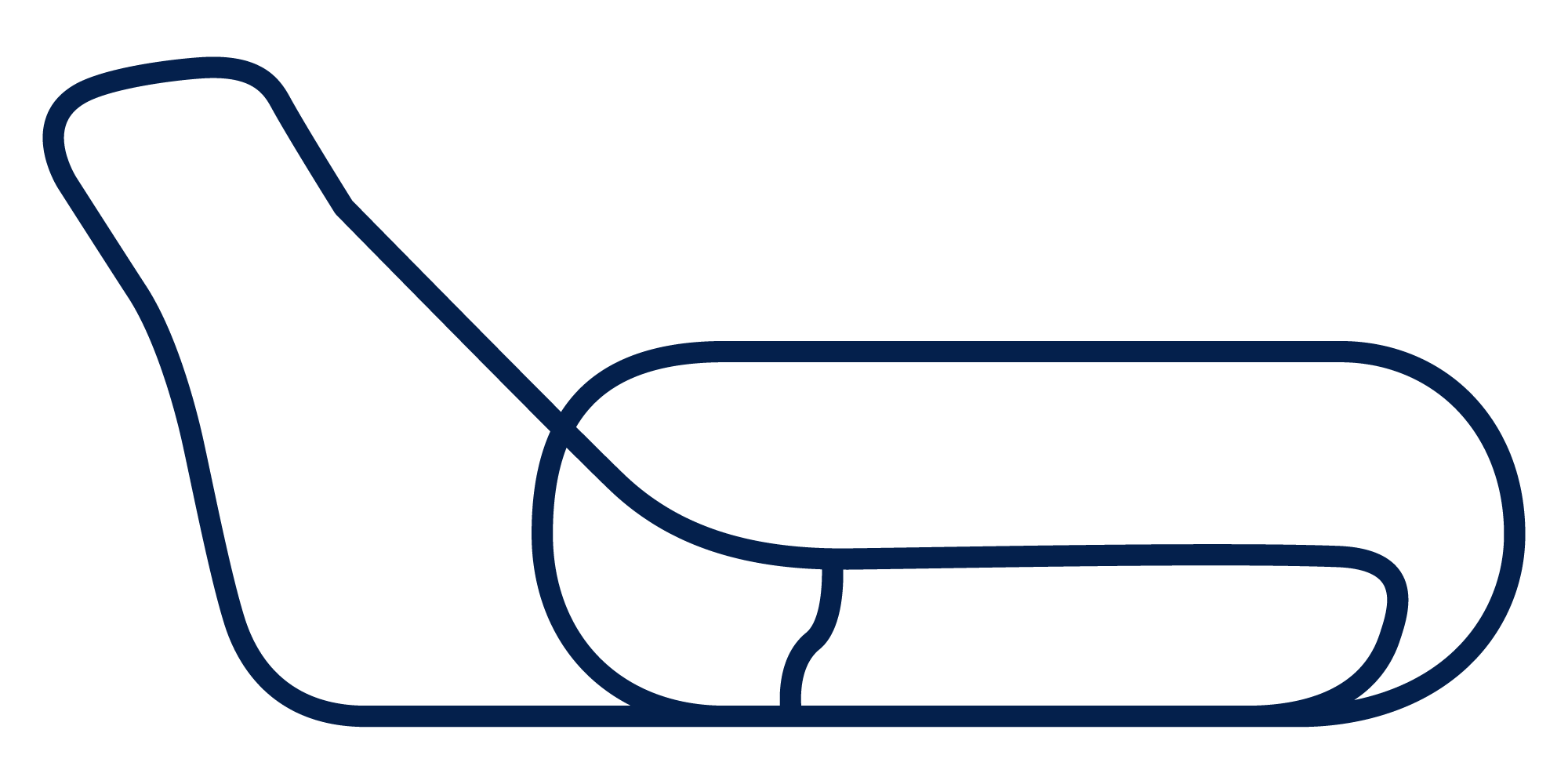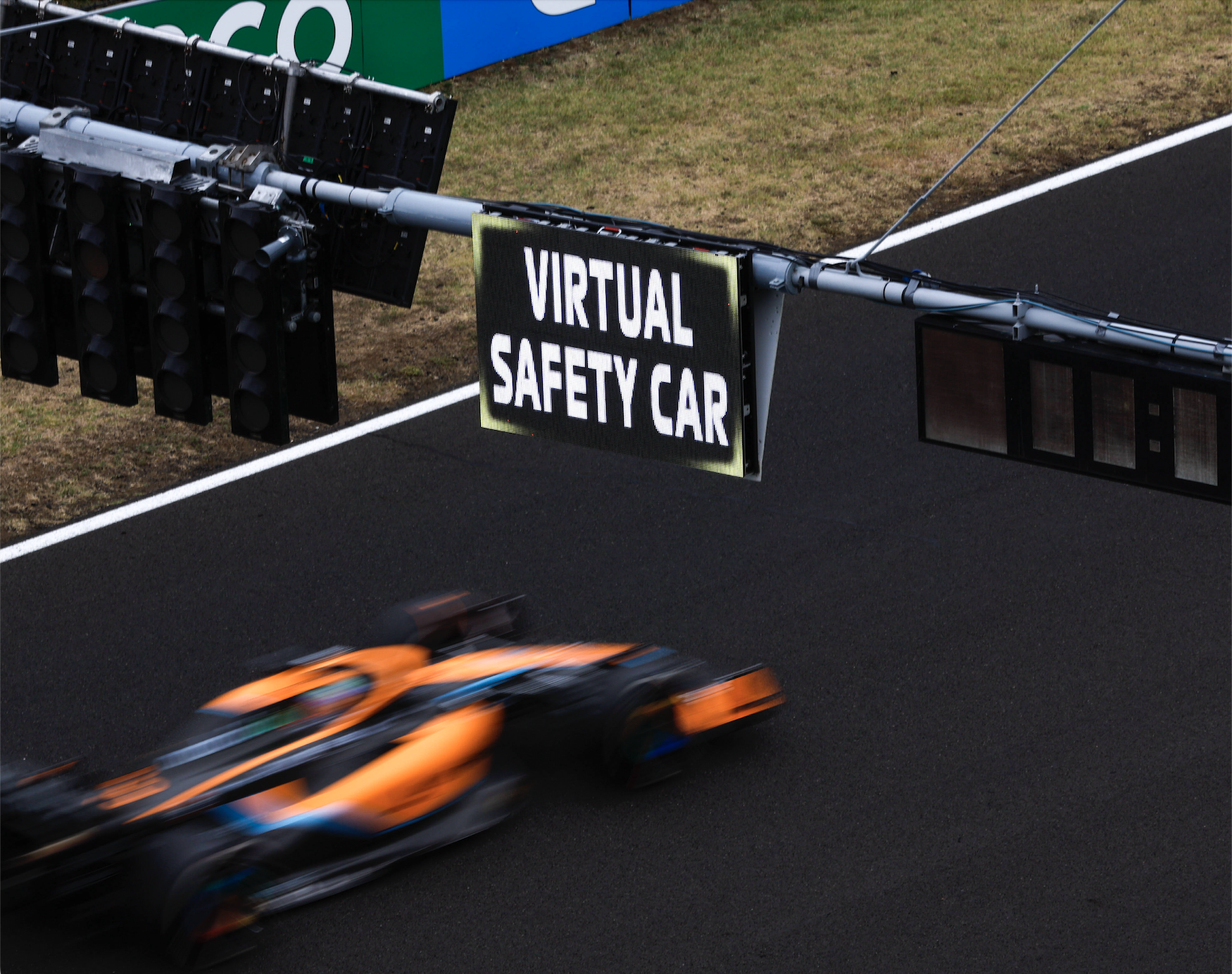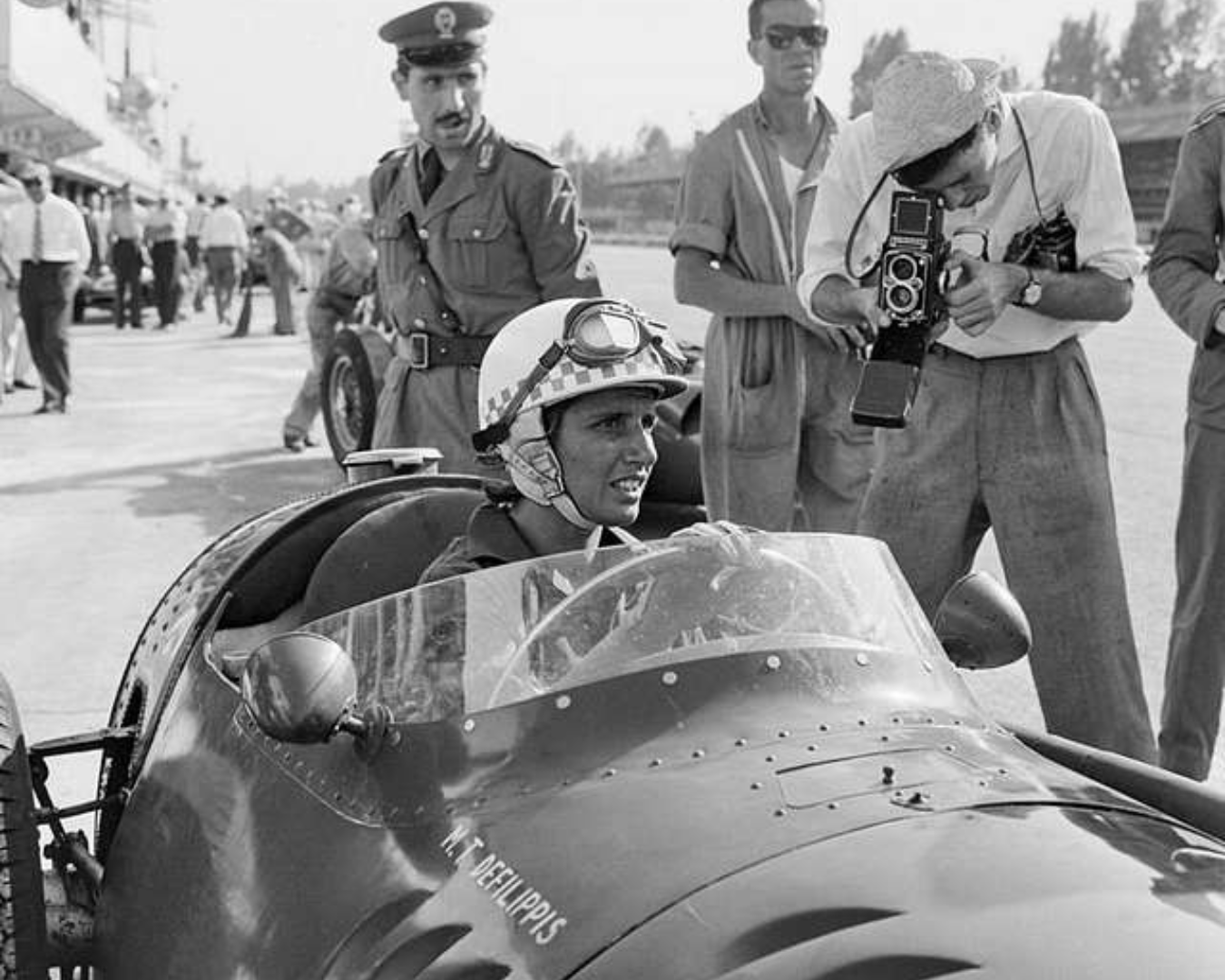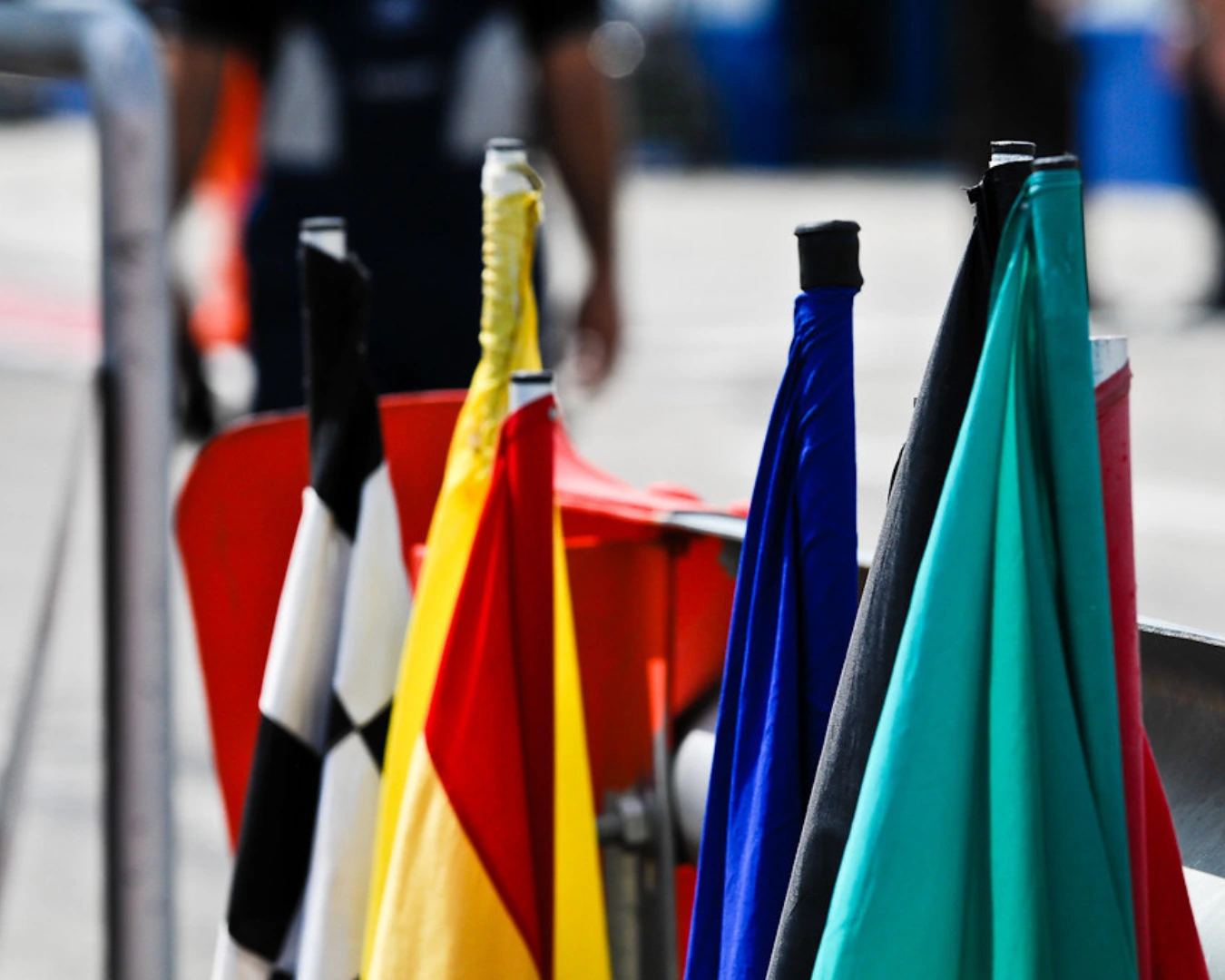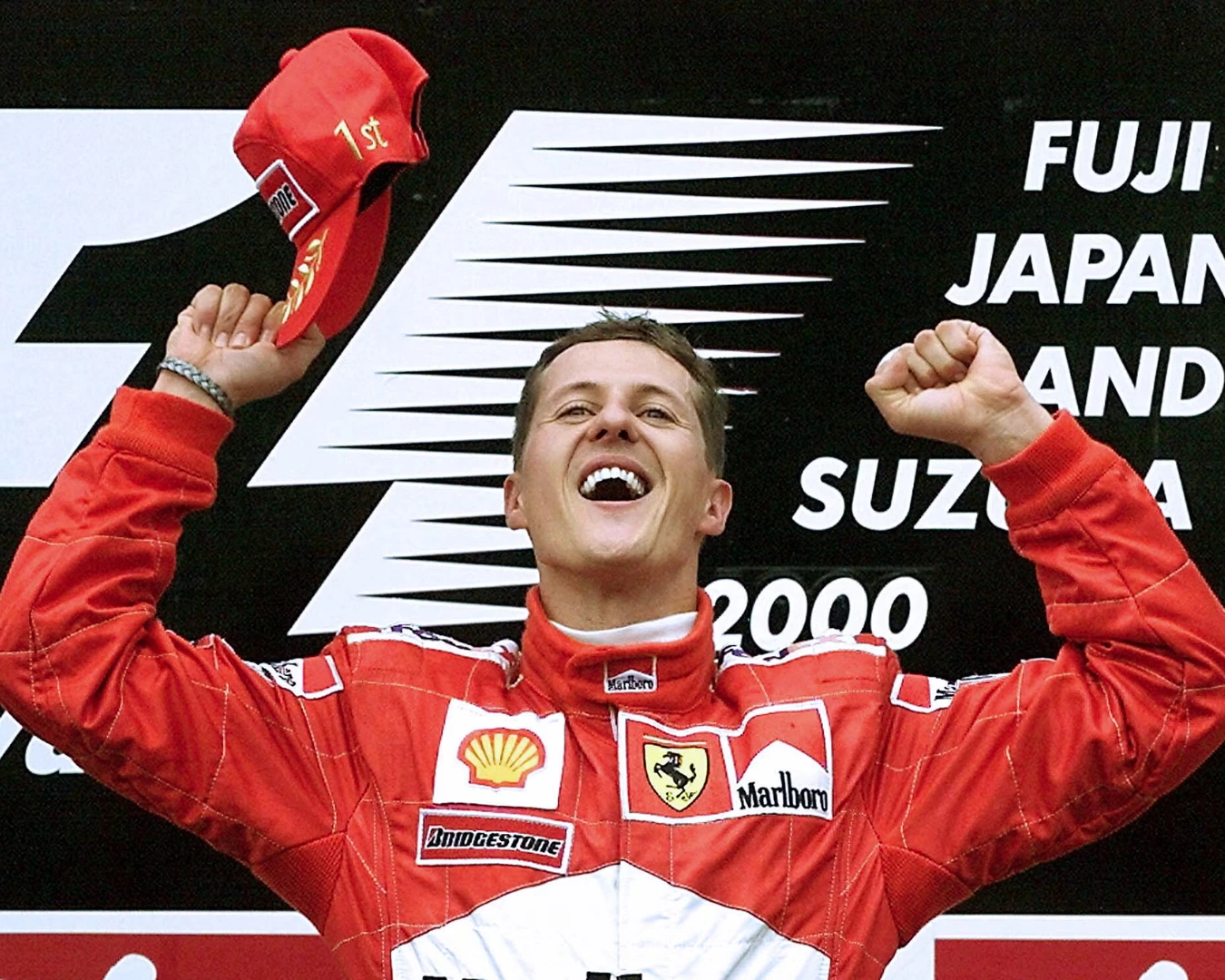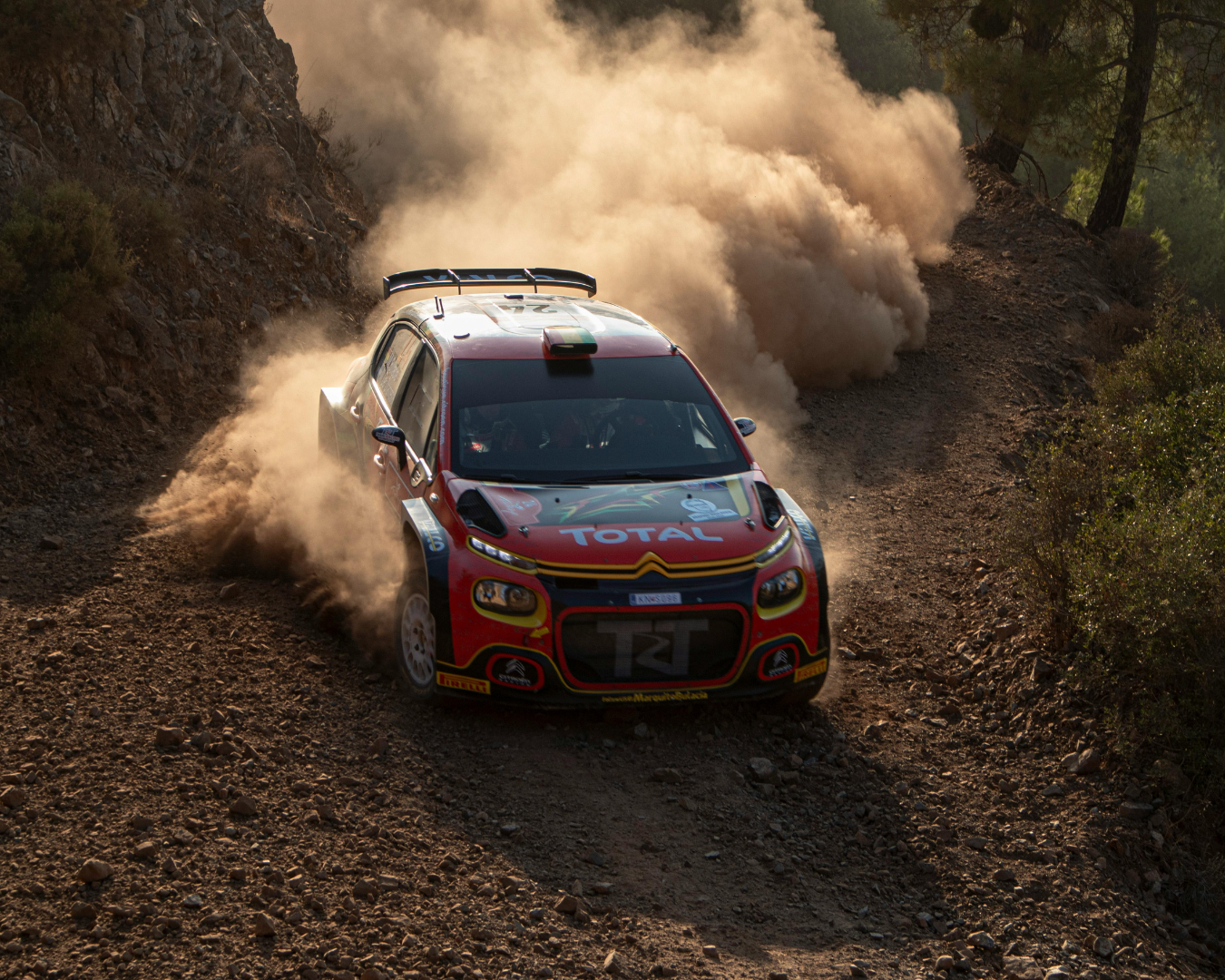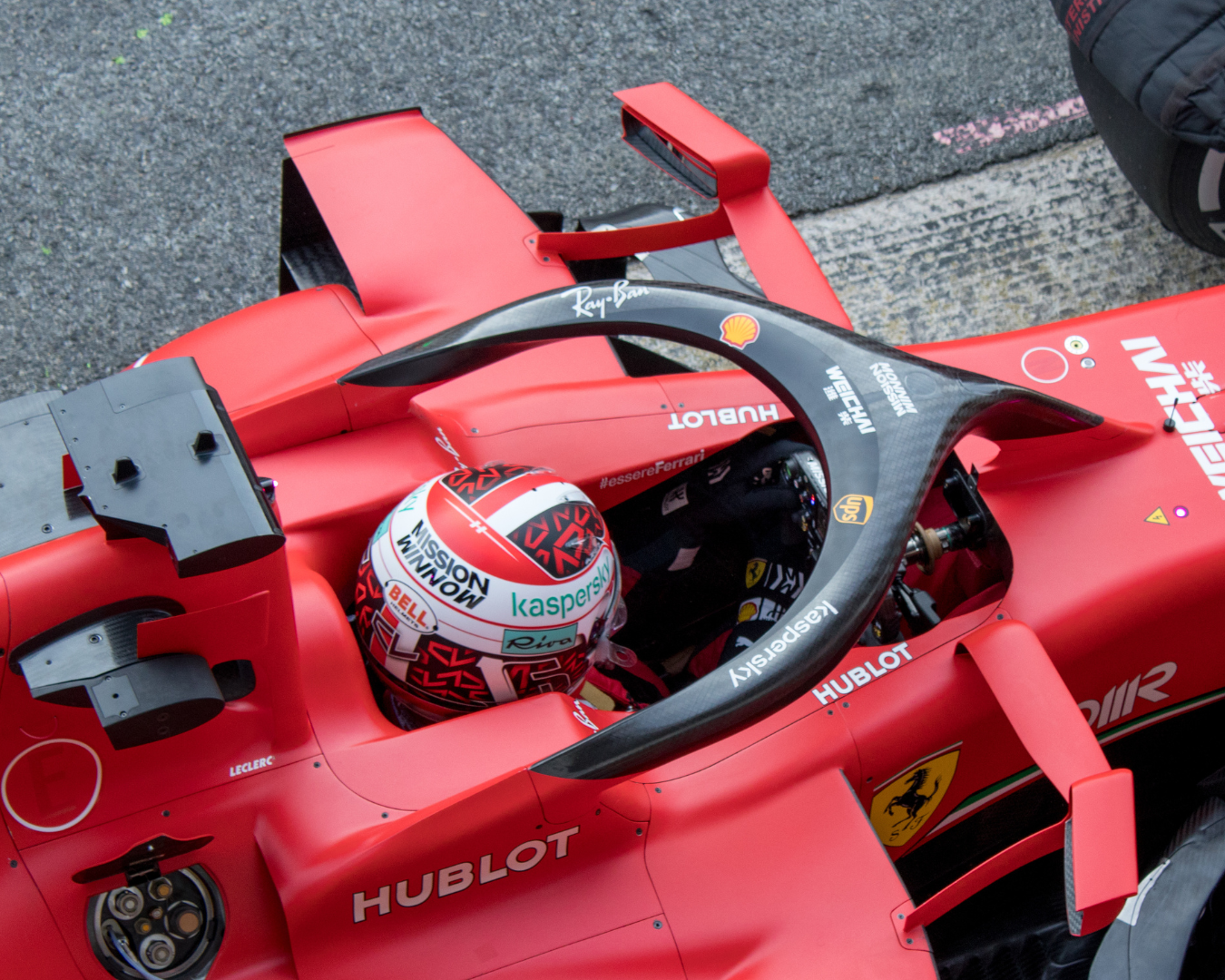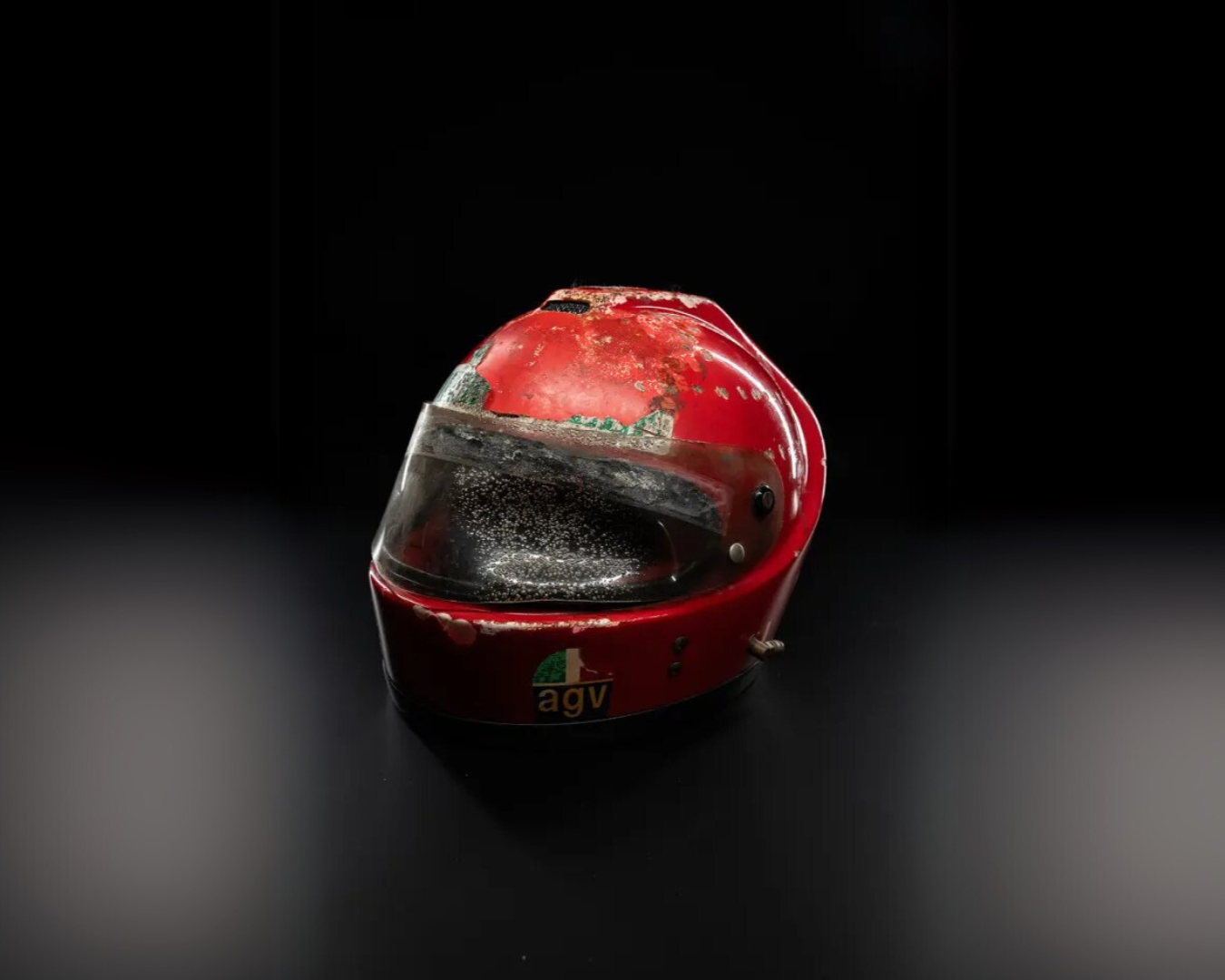Virtual Safety Car: what it is and how it works
The Virtual Safety Car is a key technology in Formula 1 that ensures safety on the track while maintaining the race pace. But how does it really work?
The Need for a Virtual Safety Car
In the world of Formula 1, safety is a top priority. Accidents, debris on the track or dangerous conditions require immediate action to protect drivers, marshals and spectators. The Virtual Safety Car(VSC) was introduced in 2015 as an alternative to the traditional Safety Car to handle critical situations without completely disrupting the pace of the race.
Unlike the physical Safety Car, the VSC requires drivers to adhere to predetermined speed limits, allowing for quicker intervention and minimizing the impact on the running of the Grand Prix.
How the Virtual Safety Car works
The Virtual Safety Car is activated in situations of localized danger on the track, such as the presence of debris or recovery vehicles. When the system is active there will be:
- speed reduction: all drivers must maintain a predefined time on each sector, significantly reducing speed.
- electronic management: on-board systems in the single-seaters monitor compliance with the speed delta imposed by the FIA in real time.
- global communication: visual signals (flags and lights) and radio messages warn pilots of VSC activation.
This mode ensures uniformity, preventing non-regulatory strategic advantages and allowing a quick return to normal competition.
Learn more about the meaning of flags and lights in Formula 1
The Benefits of the Virtual Safety Car
The introduction of VSC has transformed safety management in Formula 1. The main benefits include:
- Reduced stoppage time: the race resumes more quickly than using a physical Safety Car.
- Competitive fairness: the VSC prevents drivers and teams from gaining advantages during the neutralization phases, maintaining a competitive balance.
- Lower environmental impact: the absence of a physical vehicle on the track reduces carbon emissions and the risks associated with its management.
This technology has proven to be particularly effective in localized risk situations.
The security of the Halo System
Iconic situations: the impact of VSC on races
Over the seasons, the Virtual Safety Car has played a crucial role in various Grand Prix, influencing strategies and results.
- Monaco GP 2015: one of the first appearances of the VSC demonstrated its potential to maintain order and safety on a particularly narrow and complex track.
- Singapore GP 2019: The VSC has been used on several occasions to quickly manage debris on the track without requiring the entry of the physical Safety Car.
These incidents highlight the importance of VSC as a safety and management tool.
An essential innovation for Formula 1
The Virtual Safety Car represents a step forward in Formula 1 safety management. With this technology, it is possible to balance the protection of drivers and marshals with the desire to keep the race flowing. As the technology continues to develop, the future of Formula 1 promises to be even safer and more exciting.
The path to becoming a professional test driver
Women in Formula 1: A tribute to the stars of the track
Women in Formula 1 have written extraordinary pages in motorsport history, challenging stereotypes and taking on a traditionally male-dominated world.
The role of women in Formula 1: a challenge to time
Formula 1, with its gripping races and legendary drivers, is often perceived as a world dominated by men. However, female participation in the championship has deep roots dating back to the early days of competition. Although few have made it to the top level, women in Formula 1 have proven that talent and passion know no gender. This article aims to pay tribute to the female protagonists who have competed in the championship, inspiring future generations.
The roll of honor of the Grand Prix in Monza
Maria Teresa de Filippis: the pioneer of women in Formula 1
In 1958, Maria Teresa de Filippis became the first woman to compete in Formula 1. The Neapolitan driver debuted in a Maserati 250F, facing world-class opponents. Although her participations were limited, Maria Teresa proved that women could also compete at the highest level, defying prejudice and convention.
Her best result was a tenth place in the Belgian Grand Prix, an extraordinary achievement at the time. Despite the difficulties, her presence in the championship marked a historic moment, paving the way for future female participation.
Lella Lombardi: The Legend of the Half Point
Lella Lombardi is, to this day, the only woman to have won points in Formula 1. Born in Frugarolo in 1941, Maria Grazia "Lella" Lombardi began her career as a touring car and karting driver, reaching Formula 1 in 1974.
Her most iconic moment came in 1975 at the Spanish Grand Prix. Despite a dramatic race marked by a serious accident, Lella finished in sixth place, earning half a rainbow point. This result remains an undefeated record, a symbol of his talent and determination.
After Formula 1, Lella founded a racing stable, dedicating himself to the growth of new talent and consolidating his legacy in motorsport.
Racing car movies: 10 unmissable titles for those who love cars and engines
Giovanna Amati: The Last Italian in Formula 1
Giovanna Amati was the last Italian woman to compete in Formula 1, in 1992 with the Brabham team. Born in Rome in 1959, her motorsport career had a difficult start, with a kidnapping interrupting her youth. Despite this, Amati made her way in the racing world, moving from Formula Abarth to Formula 3, before moving up to Formula 3000.
In 1991, after a test with Benetton, she got her chance in F1 with Brabham. Unfortunately, his inexperience and the team's technical meltdown had negative repercussions, and in the first three GPs of the season he failed to qualify. This led to his replacement by Damon Hill.
Although his Formula 1 adventure was short-lived, Amati continued to race, winning the Porsche Women's SuperCup in 1993 and participating in other competitions. Her career, unfortunately cut short prematurely, remains a symbol of determination and resilience in women's motorsport.
The future of women in Formula 1
Despite the difficulties, the landscape is changing. Initiatives such as the W Series, a women-only championship that has paved the way for the visibility of female talent, are attracting attention. Added to this is the recently launched F1 Academy, a platform dedicated to supporting young female drivers with the goal of facilitating their access to the highest categories of motorsport.
Drivers like Jamie Chadwick ( 3-time W Series Champion ) are proving that women can compete at the highest level. The hope is that, in the near future, we will see a significant return of women to the Formula 1 grid, not only as drivers, but also as engineers, managers and technicians.
Sports driving: what it is and how the courses work to learn it
Formula 1 flags and lights: complete guide to the meanings on the track
Flags and lights are essential tools for communication during a Formula 1 race. Each signal has a specific meaning that drivers and teams must interpret carefully.
In every Formula 1 Grand Prix, flags and lights are crucial in communicating crucial information about the track to drivers around the world. Each signal indicates something specific-from the presence of hazards to changes in the weather. But how can we, as spectators, interpret these signals to better understand what is happening on the track? Here's a guide so you can fully enjoy every race.
Precision and adrenaline come together in regularity car racing
The Flags of Formula 1
Flags in Formula 1 are essential tools for sending clear and timely directions to drivers. With unique colors and symbols, each flag is easily distinguishable even at high speeds. The most important ones include:
Red Flag
The red flag signals thatthe race has been stopped, usually due to a serious accident or compromised safety conditions. All drivers must stop in the pits or along the track, and the race does not resume until all safety conditions are met.
Yellow Flag
The yellow flag is one of the most important signals on the track. It indicates a danger in sight (e.g., an accident or a stopped vehicle) and drivers should slow down and not overtake. The yellow flag can be displayed in two ways:
- Yellow wave flag: The driver should reduce speed, avoid overtaking and prepare for a possible change of direction.
- Static yellow flag: It is shown in case of static danger in a specific area of the runway.
- Double yellow flag: Indicates a serious hazard, such as an accident partially or completely obstructing the track or the presence of marshals working on the track.
Green Flag
The green flag indicates that the track is clear of obstacles or hazards. It is usually shown after a red flag (race stoppage) or after an obstacle has been removed. Drivers can resume their normal speed and pace.
Blue Flag
The blue flag is shown when a driver is about to be overtaken by another driver who is faster and ahead in the standings. This warning, shown in the lapped stages, serves to inform the driver that he or she must give way to the faster driver. It is not a hazard warning, but an indication to facilitate safe overtaking.
Checkered Flag
The checkered flag is the signal that the race has come to an end. It is waved on the last pass of the race leader to indicate that the race is over.
Black Flag with Orange Disk
When a driver receives a black flag with an orange disc, it means that his vehicle has a serious technical problem that could compromise safety, and he must immediately withdraw from the race for safety reasons.
White Flag
The white flag signals a slow vehicle on the track, such as a recovery car or another driver facing difficulty. Drivers should pay attention to the situation, but not slow down drastically.
Black Flag
The black flag indicates the immediate disqualification of a driver from the race. It is a maximum and severe penalty, used only in cases of serious infractions or behavior not in accordance with the sporting regulations. The flag is always accompanied by a sign with the number of the driver concerned.
Get on board and discover the pure adrenaline rush of the track
The Lights of Formula 1
Lights are another vital communication tool in Formula 1.
Green Light
The green light indicates thestart of the race. When the light goes out, the drivers can start. This occurs after a sequence of red lights come on and then go off to mark the start.
Red Light
The red light is turned on to mark thestart of the countdown before the start. When all the red lights are on, the drivers must stand still on the grid. Once the lights go out, the race begins.
Blue Lights (Flashing Blue Light)
This light signals that a driver is about to be lapped and must give way. It is a communication similar to the blue flag, but often used when there are multiple drivers who may be involved in simultaneous lapping situations.
Yellow Light (Flashing Yellow Light)
When the flashing yellow light is activated, it means there is a dangerous situation on the track, similar to the yellow flag. Drivers should reduce speed and not overtake.
Red Light (Steady Red Light)
In the event of a race stoppage, a steady red light is illuminated. This warning serves the same purpose as the red flag and indicates that the race has been suspended.
On-track communication is one of the keys to success in Formula 1, and flags and lights are at the heart of this system.
What to give to a car enthusiast?
Michael Schumacher: the legend of Formula 1
With 7 world titles and 91 victories, Michael Schumacher is one of Formula 1's greatest icons. His extraordinary career has left its mark, with Monza often featuring the "Kaiser" in unforgettable feats.
Michael Schumacher is a name that resonates as synonymous with excellence in motorsport. With his incredible determination, his ability to adapt to technological changes and his unwavering commitment to improvement, Schumacher revolutionized the concept of a driver. The Monza circuit, the "home" of Ferrari, was one of the tracks where the German experienced some of his most memorable victories, further enhancing his status as an absolute icon of Formula 1.
The beginning of an extraordinary career
Michael Schumacher is considered one of the greatest drivers of all time. Born in Hürth, Germany, on January 3, 1969, he showed extraordinary talent for motorsport from an early age. His passion for speed began at age 4 on karts, a training ground that allowed him to hone his skills and catch the attention of international talent scouts. Making his Formula 1 debut in 1991 with the Jordan team, it did not take long for Schumacher to prove his worth.
Successes with Benetton and rise to Ferrari.
After his debut, Schumacher joined the Benetton team, where he won his first two world championships in 1994 and 1995. With these victories, the German driver established himself as a dominant force in the world of Formula 1. However, it was the move to Ferrari in 1996 that turned him into a legend. With the Maranello-based stable, Schumacher not only won five consecutive titles from 2000 to 2004, but brought the Prancing Horse back to the top of motorsport after 21 years. His dedication and ability to build a winning team around himself were crucial to Ferrari's successes.
The special bond between Schumacher and the Temple of Speed.
Monza has always held a special place in Schumacher's heart. With five victories at this iconic circuit, the German solidified his relationship with Italian fans, earning him the nickname Kaiser. His last victory at Monza in 2006, followed by the announcement of his first retirement, remains one of the most emotional moments in Formula 1 history.
Drive toward your dream to become a sports car driver
Technology and the cars that made history
One of the defining aspects of Schumacher's career has been his relationship with the technology of Formula 1 cars. Throughout his career, the cars he has raced in have been the protagonists of continuous evolution, and Schumacher has been a key element in this development.
In 1994, with the Benetton B194, the German won his first world title, a car distinguished by its refined aerodynamics and Ford V8 engine. However, it was with the Ferrari F2002 that Schumacher reached one of his technical heights, thanks to its extremely rigid chassis and V10 engine that allowed him to dominate the 2002 season. In particular, the F2004 is considered one of the highest-performance cars ever built, as well as the most successful car produced by the Maranello-based team. With a Ferrari 053 V10 engine that generated about 900 horsepower, combined with the electronic control system and active suspension control, the F2004 represented the pinnacle of technology at the time. This level of innovation allowed Schumacher to win 13 of the season's 18 races, cementing his reputation as one of the most accomplished drivers.
Michael Schumacher's legacy in motorsport
Schumacher's contribution to Formula 1 goes beyond his impressive records including seven world titles, 91 victories and 68 pole positions. He redefined the concept of the professional driver, raising the level of physical and mental preparation to new standards. His influence is still reflected today in his training methods and technical development of cars.
A key aspect of his career was his meticulous approach to physical and mental preparation. Schumacher was among the first to introduce rigorous physical training and continuous monitoring of drivers' psychological performance, helping to change the approach to a driver's preparation.
Despite his unfortunate absence from public scenes due to a skiing accident in 2013, Michael Schumacher remains a symbol of excellence and determination.
Behind the scenes of training an F1 driver
The problem of hybrid cars in Rallying: what went wrong in the WRC
Rally1 rally cars have been a great technological experiment, but their future, at least for the time being, is already sealed. Why has this innovation failed to establish itself in the WRC?
The introduction of hybrid cars in the World Rally Championship (WRC) in 2022 was hailed as a momentous breakthrough. At last, this category of motorsport was also marrying sustainability without sacrificing spectacularity. However, less than three years after its debut, the hybrid system is about to be shelved. Starting in 2025, Rally1s will revert to being cars with traditional thermal engines, marking the end of an interlude that has left more questions than answers. But what went wrong?
The promising start of hybrid rally cars
The Rally1 hybrids were equipped with a plug-in system capable of delivering a 100 kW (134 horsepower) boost through an electric motor powered by a 3.9 kWh battery. This system, combined with the classic 1.6-liter turbo gasoline engine, promised to combine power, speed and sustainability.
The hybrid has brought impressive performance, with the Rally1s proving to be among the fastest cars ever in the WRC. However, the increase in power meant a significant increase in development and operating costs. Here began the disillusionment.
Learn more about the world of rallying and its characteristics
Early problems between cost and technical complexity
One of the main obstacles was the budget required to develop and maintain the hybrid system. The technology, designed by supplier Compact Dynamics, was innovative but expensive. Its impact was felt mainly by private teams and those with limited resources, making the championship less affordable. In addition, system malfunctions were frequent: drivers often complained about the need to reset the system during races, a problem that undermined confidence in the hybrid.
Even major manufacturers, such as Toyota and Hyundai, struggled to balance costs. Citroën's untimely exit exacerbated the situation, leaving a vacuum that further complicated the championship's financial model. Although the FIA attempted to support the teams financially, the results were not enough to ensure the survival of the project.
Don't miss the big events in Monza: technology and speed await you
Why did hybrid rally cars fail?
The hybrid proved ill-suited to the unique context of rallying, where extreme conditions demanded simplicity and reliability. Although the system was capable of improving performance, its complexity often overshadowed the benefits. Managing the extra weight introduced by the battery and electric motor was a further disadvantage, negatively affecting the cars' agility.
Despite initial ambitions, electrification in rallying has shown its limitations. Unlike other motor sports such as Formula E, where electric is the absolute protagonist, rallying requires technologies that can cope with a variety of surfaces, weather conditions, and long distances without any margin for error.
Explore the sustainable initiatives of the Monza National Autodrome
A glimpse into the future
From 2025, the WRC will return to exclusively thermal cars, but with some important changes. The cars will be lighter due to the removal of the hybrid system, with reduced power to ensure greater sustainability and affordability. In addition, the introduction of 100% sustainable fuels will maintain the championship's commitment to ecology, without the technical complications of electrification.
This transition represents a pragmatic choice. By eliminating the complexity of the hybrid, the WRC aims to reduce costs, simplify operations, and ensure fairer competition among teams. The challenge will be to maintain the spectacularity and audience appeal that are key to the success of the sport.
Lessons for motorsport
The experience of hybrid in the WRC teaches us that not all technological innovations are suitable for every context. Although electrification is a must for the automotive industry, motorsport requires tailored solutions that balance performance, sustainability, and economy.
With the transition to thermal cars from 2025 and further regulatory evolutions planned for 2026, the WRC is preparing to write a new chapter. Despite the abandonment of the hybrid, rallying remains a sport capable of adapting and innovating, preserving its spectacular essence and continuing to thrill fans around the world.
The technological future of the automotive industry
Halo system in Formula 1 | A revolution for driver safety
The introduction of the Halo system in Formula 1, protection that has changed the way drivers deal with the risk of serious injury, is proof that safety has always been a key priority in motorsport. Over the years, technology has helped make tremendous progress in this area, and this system represents one of the most significant developments in recent years.
What is the Halo system?
The Halo system is a driver's head protection device that was made mandatory in Formula 1 in 2018. It is a titanium structure surrounding the top of the cockpit designed to protect the driver's head from side or frontal impacts during an accident. The Halo System was developed to meet specific safety requirements, specifically to protect against debris that may enter the head area or impacts with other vehicles. Its minimalist but robust design initially drew much criticism from riders and fans, but its effectiveness was later widely demonstrated.
The benefits of the Halo system in Formula 1
The introduction of the Halo system has had a positively significant impact on the safety of Formula 1 drivers. The device was designed to withstand incredible forces, up to 12 tons, without compromising the driver's visibility or agility while driving. Thanks to this system, it was possible to significantly reduce the risk of serious head injuries by providing unprecedented protection. In addition to physical protection, Halo has also helped change the mindset in motorsport, pushing for continuous improvement in car safety.
Take the course to become a responsible pilot
Romain Grosjean's miraculous rescue
A glaring example of the effectiveness of the Halo system occurred during the Bahrain Grand Prix in 2020. Driver Romain Grosjean, on board his Haas, had a terrible accident; after Daniil Kvyat's AlphaTauri touched his single-seater, the French driver crashed into the barriers, leading the No. 8 VF-20 to break into two parts, with the front one enveloped in a cloud of fire. Although the vehicle was destroyed and on fire, Grosjean managed to save himself thanks to the integrity of the car's survival cell, reinforced by the Halo system. This incident demonstrated without a shadow of a doubt how crucial the system is for safety. The driver was able to exit the vehicle on his own, without head damage, and suffered only minor hand burns and injuries. The incident received worldwide media attention, with many recognizing the critical role of the Halo system in protecting the pilot's life.
Gran Turismo Automobili, the myth hidden behind the GT abbreviation
Max Verstappen and Lewis Hamilton at Monza.
Another example of the effectiveness of the Halo system occurred just during the 2021 Italian Grand Prix. In this race, Max Verstappen and Lewis Hamilton were involved in a spectacular accident, with Verstappen's Red Bull landing on top of Hamilton's Mercedes. Fortunately, both drivers managed to emerge unharmed thanks to the adoption of the Halo system, which prevented the direct impact from damaging Hamilton's head. This incident further confirmed the value of the device in protecting Formula 1 drivers, even in seriously dangerous situations.
An essential device for pilot safety
The Halo system has been a real revolution in the safety of Formula 1 drivers. Since it was introduced, it has saved several lives, protecting drivers during accidents that could have been fatal without it. While initial criticism was about its aesthetics, today it is undeniable that the Halo system is one of the greatest safety achievements in motorsport.
9 interesting facts about the Autodromo Nazionale di Monza and Formula 1
Niki Lauda's helmet: the strange reappearance
The helmet Niki Lauda wore during the tragic 1976 crash at the Nürburgring is not only a piece of history, but a true symbol of strength and resilience. This helmet, damaged by flames and subsequently stolen for 37 years, has finally been returned to motorsport history.
The dramatic accident
August 1, 1976 is a date etched in the memory of Formula 1 fans. During the German Grand Prix, Niki Lauda, at the wheel of his Ferrari 312 T2, was the victim of a terrible accident. His car skidded and caught fire at Bergwerk corner, the point on the circuit farthest from the pits, trapping the driver in an inferno of flames. Lauda suffered severe burns and injuries that could have ended his career. However, against all odds, he returned to the track only 42 days later. The helmet he wore that day, badly damaged, has become a symbol of the courage and determination that defined his legend.
From 1922 to the present, the history Autodromo Nazionale Monza
Theft and discovery of Niki Lauda's helmet
After the accident, Niki Lauda's helmet was kept by Gino Amisano, founder of the AGV company. However, in 1987, during an event in Milan, it mysteriously disappeared. For decades, its fate remained shrouded in mystery, fueling speculation among collectors and fans. Only in the spring of 2024 did the helmet reappear during an auction in Miami, with a starting price of $60,000. The Dainese Group, owner of the AGV brand, managed to recover it, bringing it back to Italy. This precious heirloom was displayed in 2024 at Eicma, in Milan, as a tribute to one of the icons of Formula 1.
10 curiosities about Formula 1
Niki Lauda's helmet is not just history
The AGV X1 helmet, with its iconic red livery, is not just a museum piece. Signs of fire, such as ruined paint and a warped visor, tell a story of challenges overcome. This object represents a pivotal moment in Formula 1 safety, marking the beginning of an era when attention to driver protection became a priority. Today, Niki Lauda's helmet is part of the DAR (Dainese Archive), a permanent collection celebrating advances in dynamic sports safety. An heirloom that invites fans to reflect on the importance of technology in racing.
The legacy of a symbol
Lauda's accident had a significant impact on the development of safety standards. The changes introduced in helmets, fire suppression systems, and circuit structures find their roots in that tragedy. Niki Lauda not only changed the way we approach racing, but also inspired generations of drivers and engineers to pursue higher standards of protection. For motorsports fans, Niki Lauda's helmet is a tangible reminder of how courage and technology can go hand in hand.
Join an exclusive tour of the Monza National Autodrome
